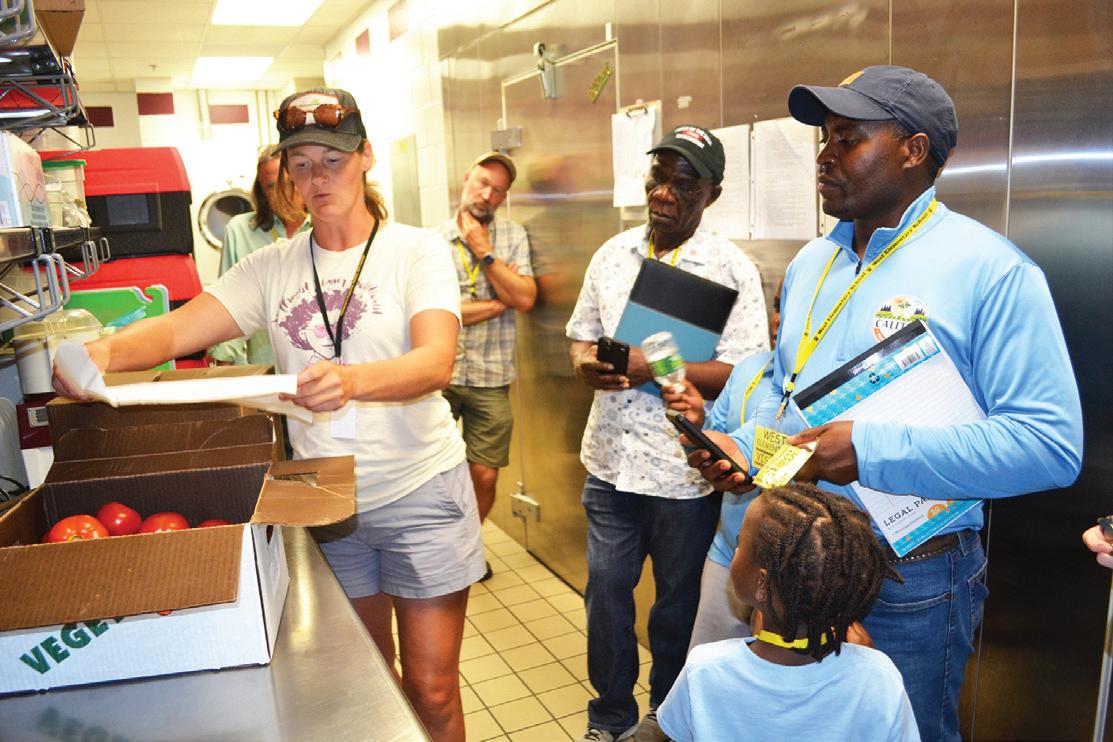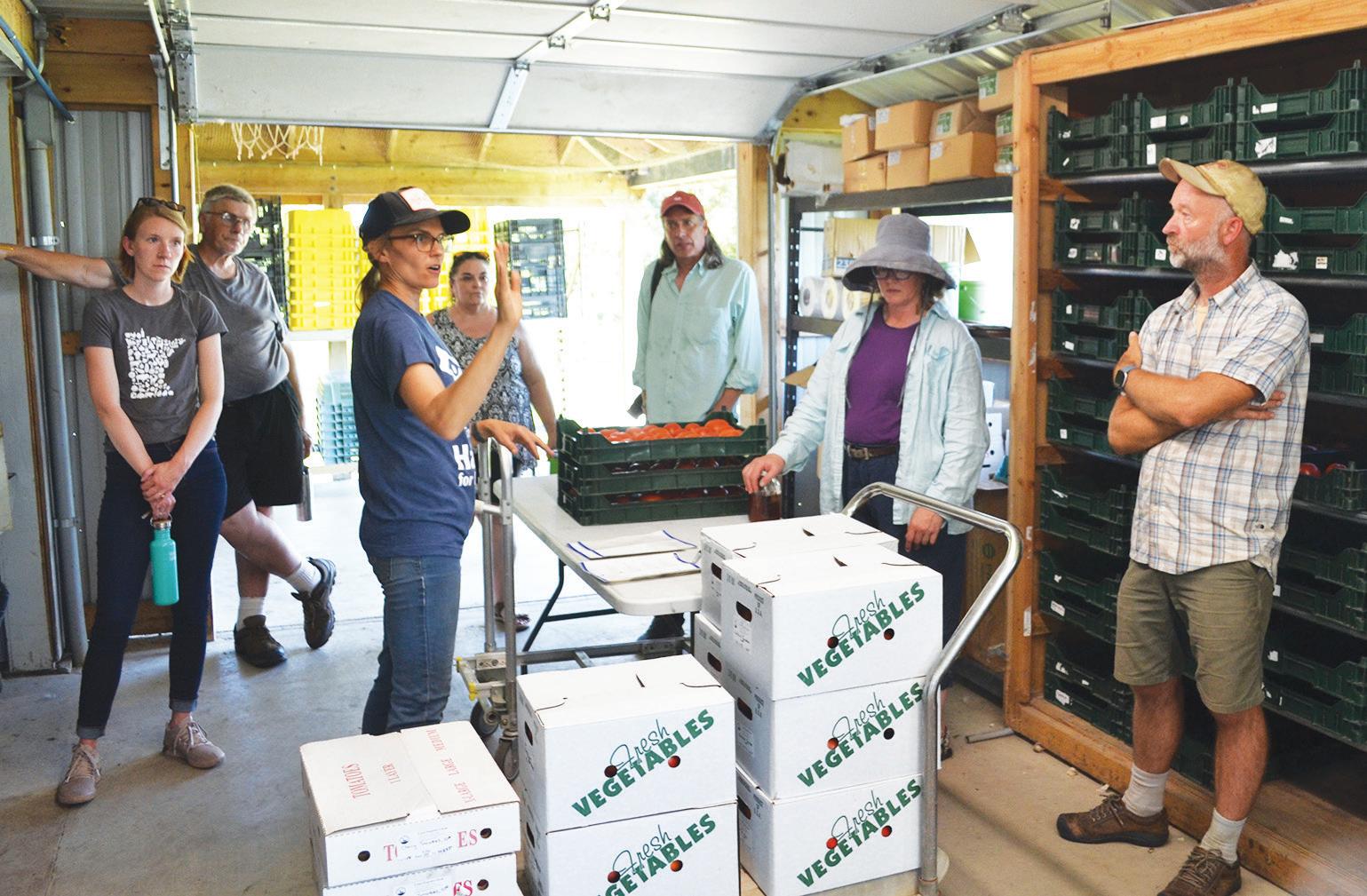
8 minute read
Lunchroom Stewardship
Thoughts on Local Food, School Cafeterias…& Pink Coleslaw
Serving locally produced food in school cafeterias, known as “farmto-school,” is one of those concepts that, like puppies and pizza, just about everyone thinks is a good idea. After all, it provides healthier food for young minds and bodies while putting more money directly in the pockets of farmers. What’s not to like?
Advertisement
But there are numerous obstacles that stand in the way of connecting local farms and local schools on a consistent basis. For one thing, many of today’s schools lack the kitchen facilities and staff to prepare fresh food straight off the farm. In addition, tight budgets make it difficult to pay local farmers what they deserve — major food service companies simply provide a cheaper, if less nutritious, product. And it can be difficult for a local farmer to know how best to approach a school nutrition director about their product, and to know exactly how to match supply and demand while making regular deliveries. Finally, there’s the fact that in the Midwest, anyway, the prime growing season for items like fruits and vegetables and the regular school year don’t exactly coincide.
But in recent years, numerous school districts have overcome such obstacles to connect directly with farmers and make locally produced food more than a rarity on cafeteria tables. For example, more than 65% of U.S. school food authorities participating in the USDA’s latest farm-to-school census, which took place during the 20182019 school year, reported that they were involved in farm-to-school activities. That represents over 42 million students. The number of Minnesota school districts engaged in farm-to-school practices rose from 18 in 2006 to 262 in 2019, which impacts over 520,000 students.
In Minnesota, one thing that’s helped smooth the path between the vegetable plot and the lunch table has been increased support for farm-to-school initiatives via the state department of agriculture. For example, state Farm-to-School and Early Care Grants support Minnesota school districts and early childhood education centers that want to buy and serve Minnesota agricultural products. In fiscal year 2024, the Minnesota Department of Agriculture expects to award up to $935,000 to reimburse school districts and early care centers for buying Minnesota grown and raised foods used in federal meal programs. School districts can also get state funding to purchase kitchen equipment that supports their handling and processing of
Farm-to-School Funding
For more information on grants available to support farm-toschool initiatives in Minnesota, see mda. state.mn.us/farm-school-early-caregrants or contact the Minnesota Department of Agriculture’s Kate Seybold at kate.seybold@state.mn.us.
schools and farmers in the region. Her work encompasses 12 kitchens and between 4,800 and 5,200 meals served in a given day. She regularly works with around 15 farmers, sourcing mostly produce, but also some meat and dairy products. The schools have also started bringing in local maple syrup, honey, and dry beans. Haag estimates that, on average, the food they buy directly from farms is within a 15-to-30 minute drive of the schools. At the peak of the farm-to-school season, which is in early fall, 80% of the schools’ vegetables and 100% of the beef is locally sourced. Haag estimates over the entire course of the school year, between 25% to 35% of the food is from local farms.
locally-sourced food. And farmers wishing to better match their growing season with the school calendar can apply for USDA Environmental Quality Incentives Program funds to erect hoop houses and other seasonextending structures.
A big reason such support is available is because groups like the Land Stewardship Project and the Institute for Agriculture and Trade Policy have been working hard during recent legislative sessions to promote farmto-school bills, winning funding for grants as well as a farm-to-school coordinator at the Minnesota Department of Agriculture. Having a paid professional available to coordinate farm-to-school initiatives is important, and not just on the state level. For example, Aimee Haag is the farm-to-school coordinator for the cooperative district that encompasses the central Minnesota communities of Hutchinson, Litchfield, and Dassel-Cokato.
For the past three years, Haag has served as the link in the food chain connecting the
The Hutchinson, Litchfield, and Dassel-Cokato initiative has been called the gold standard of farm-toschool programs in the state, in no small part because school officials have dedicated staff time to its coordination. And Haag is a good fit for the job. She had worked in the classroom before, but even more importantly, she and her partner, Andy Temple, for a time raised vegetables in the area. That means Haag knows the challenges farmers face, and has made lots of connections with the people raising food in the area.
Haag recently sat down to talk on episode 322 of LSP’s Ear to the Ground podcast about what is involved with developing and maintaining a successful farm-to-school program: landstewardshipproject.org/ podcast/ear-to-the-ground-222-lunchroomstewardship. Below are excerpts of that conversation.
Starting With Low-Hanging Fruit
“When launching a farm-to-school program, start out with things that students love, like carrots, cucumbers, broccoli, cherry tomatoes. These foods also need minimal prep and give our kitchen staff a little bit of experience to see how orders come in.
“And it does take a little bit of planning. I know that the vegetable farmers, espe-
Lunchroom, see page 15…
…Lunchroom, from page 14 cially, are making their decisions on seeds and quantity in December. There are things that have good storage life, like potatoes and carrots and squash, that we can serve all winter, so that’s not to say that everything is over now, after a frost. And things like our proteins, our beef, and now some chicken, that will carry us through the winter too. But generally, farm-to-school conversations need to take place way ahead of the school year.”
Importance of Relationships
“My connection to the farms and the system of delivering produce has changed over the course of the three years that we’ve been doing this. When we started, I picked up every box of produce and delivered it to the schools. I can’t do that anymore — we’ve grown past that, so farmers deliver their own produce now. But I do try to make it out to the farms. It’s an important piece of knowing what their farms look like — both because I love farms and I want to grow that relationship with the people that we purchase from and, in reverse, they want to know where they’re selling to.
“We have a strong interest in food safety, too. So when we’re feeding as many students as we are, it’s important to make sure all of your boxes are checked, things are coming in right. We haven’t had any issues, but if that was the case it would be nice to say, ‘Well, I’ve seen their pack shed. I’ve seen their delivery vehicle. Everything looks great, so what’s going on here?’ And then we can dig into it.”
Food Service Staff Buy-in
“Food service staff have a really hard job. Schools can also be a really challenging place to be, and there is a tight schedule to get everything done in a day. I never expect everybody to be super-jazzed about serving cabbage again. But you can see the difference when the staff does engage with the students, or shares a story.
“For example, there was a day that the coleslaw was a little bit heavy on the red cabbage, so it kind of turned out pink. And a student kind of flipped. It was like ‘Whoa, whoa, whoa. This coleslaw looks different.’ And it’s pink of all things. And our food service staff that day engaged with the student, and told her, ‘You know, the farmers had a lot of red cabbage this week and that’s what we had, so this is what it looks like. I think you should try it — it tastes the same.’
“And she came back with an empty tray and a big thumbs up. And it was because our employee was able to take the time and had the energy, and knew why they had so much red cabbage. It might come in looking different each week. Now that student knows it might be purple this week, or it might be green, we don’t know.”
In the Classroom
“If we’re not telling that local food story in the classrooms, we’re missing an opportunity. The cafeteria is kind of loud, it’s kind of fun, it’s the students’ social hour — as it should be. So it’s hard to tell that story in the lunchroom sometimes. We are just getting to that point where we are able to get into that classroom and tell the story of community connection, through food, and celebrate it.”
Consistent Support Needed
“I can only speak for the districts that I work for that state farm-to-school funding has been important. It’s been like the legs that we stand on to reach out and try new things. We rely on that public grant funding to cover a percentage of our purchases. I think what’s important is for the state to tions. There’s a lot of things at play that a food service director or other kitchen staff doesn’t have the time and flexibility for. Are there four or five small districts that could share a part-time person to just get this off the ground? I think so.
“If you’re a farmer, I think back to when I was starting, when Andy and I were starting our farm, Rebel Soil, and it was intimidating to cold-call restaurants. School nutrition is such a different field. Everybody loves kids, and they want what’s best. And if their participation rates increase because they have a farmer selling high quality food that’s coming to the cafeteria, that’s a win.
— Aimee Haag
show a permanent level of commitment and kind of define their commitment to farm-toschool funding more than one or two years at a time. I think the farmers could really get on board with selling into institutions if they knew that this funding was going to be available for schools. It does the farmers no good if we have just a banner year of supporting them, and then two years later the funding is cut; it’s really disruptive for small farms. And I have heard from a few of the growers like, ‘Well we would buy a carrot harvester and washer if we knew this was part of our 10-year plan.’ ”
Advice to Schools & Farms
“A school district that has interest in buying local food should set a priority to have somebody like me working for their food service department to make those connec-
“So, if you’re looking to get started and you want to get started as a grower, the child nutrition director is your contact person and the things to consider are: What do you think students are going to love? What foods are going to be easy to sell to students? And what ingredients are low labor on the kitchen side? Do you have something you’re really good at, or you have the space and capacity on your farm to grow? If you do broccoli really well or you do cabbage really well, or you do salad radishes really well, go for it. Start with one thing. If we’re all just playing on our strengths, I think any working relationship will thrive when you’re genuine.” p
LSP & Community Food Systems Work
For more information on the Land Stewardship Project’s work on community-based foods, see landstewardshipproject.org/community-food or contact Amy Bacigalupo, amyb@landstewardshipproject.org, 320-269-2105; or Scott DeMuth, sdemuth@landstewardshipproject.org, 612-767-9487.









